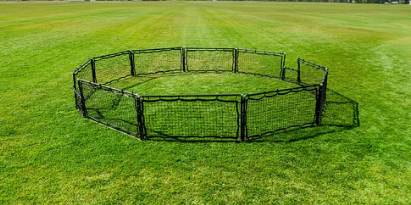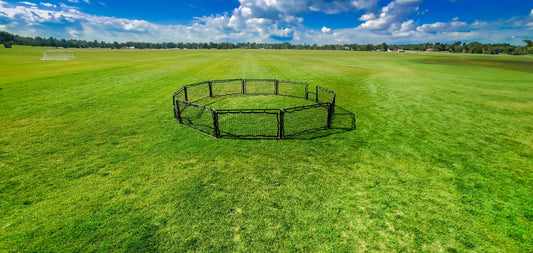PE games for elementary schools are a sweet spot where play, growth, and learning converge. As we begin to discuss some of the benefits of effective PE class, this article will help spark some new ideas for your next PE class.
In an era where screens often capture the bulk of attention, the importance of active, engaging physical education becomes increasingly evident. The early years are crucial for development, setting the stage for physical growth, cognitive absorption, and budding social interactions. PE games are more than just play; they are a cornerstone of comprehensive development, fostering not only physical strength and motor skills but also promoting teamwork, communication, and fair play. By establishing healthy habits whin a child is young they will continue this habits into middle school, high school, and beyond.
These activities are essential, providing kids with a fun outlet to expend energy, alleviate stress, and enhance emotional well-being. As we delve into the enchanting world of PE games, we uncover their potential to instill a lifelong appreciation for movement and healthy competition, crafting enduring memories in the process.
Let's embark on this journey to champion PE games in elementary school settings, advocating for a foundation that encourages vibrant, active, and joyful lives for our children. Through this exploration, we aim to highlight how integral play is to shaping their future, guiding them towards a path of health and happiness. Here are five engaging PE games that promise fun and physical literacy for our youngest movers and shakers.
Gaga Ball - Gaga Ball is an exciting and fast-paced game that combines elements of dodgeball and handball. It is played in an enclosed octagonal or hexagonal pit, usually made of wood or plastic. The objective of the game is to avoid being hit by a ball while trying to strike other players below the waist with your hands. Players start inside the pit, and one player serves the ball by throwing or bouncing it into the center. Once the ball is in play, players must use their hands to hit it at opponents. If the ball hits a player below the waist, they are out and must leave the pit. The last player remaining in the pit wins the round. Gaga Ball is loved for its simplicity, inclusivity, and the opportunity for continuous play, making it a popular choice for schools, camps, and community centers. It encourages physical activity, reflexes, and social interaction while providing a safe and enjoyable experience for players of all ages and skill levels. Alternatives to the ball used can be made based on resources available, a rubber ball is traditional where a soft ball called be used.

Four Square - Four Square is a classic and beloved playground game that brings joy to children of all ages. The game is played on a square court divided into four smaller squares, each labeled with a number from 1 to 4. To play, all you need is a bouncy rubber ball and at least four players, though more can join in the fun. Players take their positions in the four squares, with one player occupying each square. The game starts with a player serving the ball from their square. They bounce the ball once and then underhand hit it to another player's square. The rules require the ball to bounce once in the serving player's square and once in the receiving player's square before it is hit to another square. Each player must allow the ball to bounce once in their square before hitting it to someone else. The goal of the game is to hit the ball into another player's square in such a way that it becomes challenging for them to return it. The ball must remain within the boundaries of the court, and players must avoid hitting it out of bounds or directly to the next square without letting it bounce first. Players who fail to hit the ball to another square, hit it out of bounds, or allow it to bounce more than once in their square are considered "out." The player who is out rotates out of the court, and a new player joins in to take their place in the lowest-numbered square. The game continues with players trying to advance to higher-numbered squares by successfully returning the ball and outlasting their opponents. The player in square 4 is the "king" and remains in that position until they are eliminated. The game continues until a predetermined number of rounds or until a winner is determined, often the player who spends the most time in the highest-numbered square or the last player remaining in square 4. Four Square is a delightful and straightforward game that promotes quick reflexes, hand-eye coordination, and friendly competition. This is a must for any PE teacher to keep in their back pocket. It provides an inclusive and enjoyable experience for players of all ages, making it a timeless favorite on playgrounds, at schools, and during recreational gatherings. Luckily this can be played during outdoor or indoor PE game day.
Badminton - Badminton is an exciting and fast-paced racket sport that is enjoyed by people of all ages around the world. The game can be played with two players (singles) or four players (doubles) on a rectangular court, divided by a net. To play badminton, each player or team uses a racket to hit a shuttlecock, also known as a birdie, back and forth over the net. The objective is to score points by making the shuttlecock land in the opponent's court in such a way that they cannot return it successfully. The game starts with a serve, where the shuttlecock is hit diagonally from one side of the net to the other, aiming to land it in the opponent's service area. The receiving player or team must then return the shuttlecock, and the rally continues until the shuttlecock lands out of bounds, hits the net and doesn't cross over, or one side fails to return it. Players must use agility, reflexes, and hand-eye coordination to react quickly to the shuttlecock's trajectory and position themselves for effective shots. The game is played in rounds, and players or teams switch sides of the court after each round to ensure fairness. Badminton is renowned for its grace and finesse, as well as the explosive power required for fast smashes and strategic drop shots. It provides an excellent cardiovascular workout and helps improve muscle strength, speed, and agility. The first side to score a predetermined number of points, typically 21 in standard games, wins the match. However, the margin of victory must be at least two points. If the score reaches a tie at 20-20, the game continues until one side gains a two-point lead to win. Badminton is not only a competitive sport but also a social and recreational activity enjoyed by families, friends, and communities. Though this may seem like an advanced activity to elementary PE it can be a great inclusion to work on student skill. Its accessibility and versatility make it a popular choice for leisurely play in backyards, parks, and recreational facilities, while at the professional level, badminton showcases top athletes competing in international tournaments like the Olympics and World Championships.

Sardines - Sardines is a thrilling and suspenseful, fun PE game that puts a unique twist on the traditional hide-and-seek. It is often played in larger indoor or outdoor spaces and involves a group of players. At the beginning of the game, one player is designated as the "sardine." This player's task is to hide somewhere within the designated playing area while the remaining players close their eyes and count to an agreed-upon number. Once the counting is complete, the players actively search for the hidden sardine. The objective is not to be the first one to find the sardine, but rather to join them in their hiding spot secretly. As players locate the sardine, they quietly join them, huddling together like a school of sardines in a can. As the game progresses, the remaining players continue searching for the hidden group. As each new player discovers the hiding spot, they squeeze into the tightly packed space until the entire group is huddled together, resembling a can full of sardines. The suspense builds as the searching players grow fewer in number, wondering where the hiding group might be. The last player to find the hiding spot becomes the sardine for the next round, and the game starts anew. Sardines offers a unique and interactive experience, encouraging observation skills, teamwork, and creativity. It creates a sense of excitement as players navigate the challenge of finding a hidden spot and silently joining the growing group. The game fosters a lively and social atmosphere, allowing participants to bond and share the thrill of discovery. Sardines is a versatile game that can be played in various settings, such as during parties, family gatherings, or summer camps. It provides an entertaining and memorable experience for participants of all ages, offering an enjoyable twist on the classic game of hide-and-seek.
Simon Says - Simon Says is a classic and entertaining children's game that challenges participants to follow instructions with a twist. One player, known as "Simon," takes on the role of the leader, while the others become the followers. To begin, Simon stands in front of the group and issues commands starting with the phrase "Simon says." For example, "Simon says touch your nose" or "Simon says jump in place." The followers must carefully listen to the command and only perform the action if the leader includes the crucial "Simon says" at the beginning. The tricky part comes when Simon gives a command without saying "Simon says" first. If Simon says, "Clap your hands," the followers should not perform the action. However, if Simon says, "Simon says clap your hands," the followers should clap their hands. The goal for the followers is to avoid making mistakes and only follow commands that begin with "Simon says." Players who incorrectly perform an action when "Simon says" is not included are out of the game. The last player remaining or the player who correctly follows the most commands becomes the next Simon. Simon Says is a game of observation, concentration, and quick reflexes. It encourages active listening and fosters a sense of excitement as players strive to avoid being eliminated. The interactive nature of the game creates a fun and engaging atmosphere, making it a popular choice for children's parties, school events, and family gatherings. If you need any good warm up games, for your next PE lesson then this should be a great fun game to get your elementary student involved. Its simplicity and adaptability also make it easy to play in various settings, bringing joy and laughter to participants of all ages.

It's undeniable that PE activities for elementary kids are crucial for their all-around development. These gym class games are far more than mere physical exertion; they're a vibrant avenue for embedding essential life skills and values through engaging and enjoyable experiences. Each of the game ideas offers inclusivity to different interests of your students making physical education class an engaging activity.
Incorporating activities like kickball, capture the flag, and four-square into gym class not only makes fitness captivating but also nurtures teamwork and sportsmanship. Through these PE activities, children boost their physical health, agility, and coordination, laying the groundwork for lifelong wellness.
Furthermore, adapted PE ensures that every kid, regardless of ability, can participate, promoting inclusivity and empathy. This approach enhances social and emotional growth, as kids learn vital communication, cooperation, and conflict resolution skills. In the inclusive world of gym class and adapted PE, each child gets the opportunity to excel, bolstering their confidence and self-esteem through overcoming challenges and celebrating achievements together.
As guardians of our children's futures, it's our responsibility to enrich their lives with opportunities that go beyond traditional learning. PE activities provide a supportive framework for kids to explore their potential, build meaningful relationships, and revel in the joy of movement.
In an era leaning towards digital engagement, these gym class and adapted PE activities shine as beacons of active, balanced lifestyles. Let's advocate for the integration of these essential programs into educational and community settings, inspiring a generation that values fitness, teamwork, and the pure delight of play. Together, we can foster a healthier, brighter future for our kids, one great game at a time.







